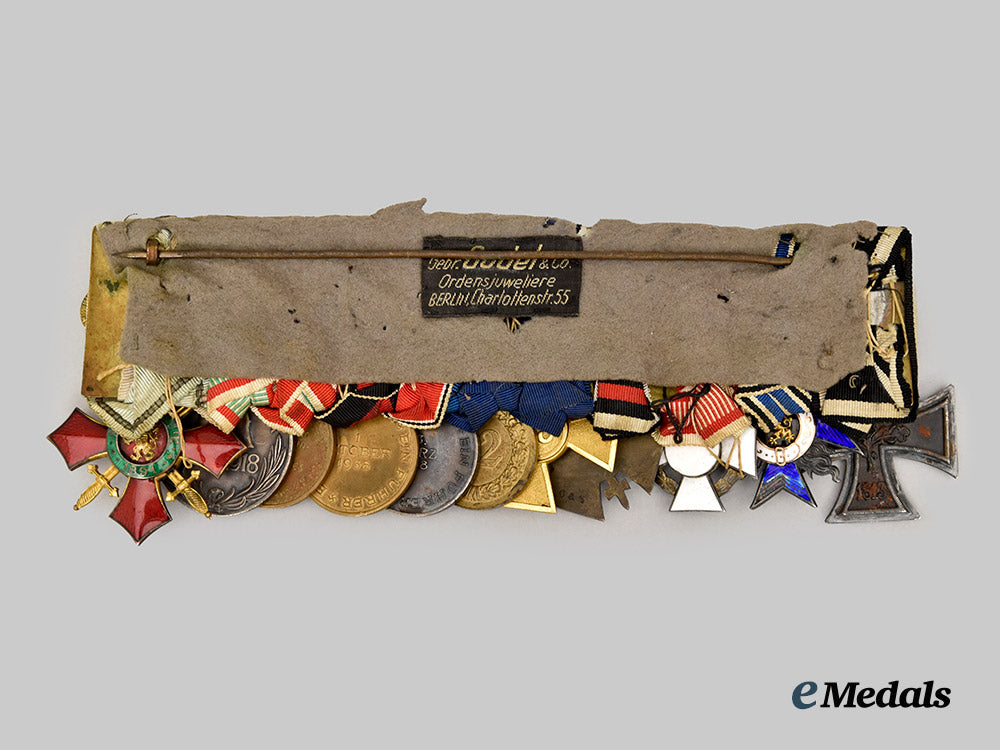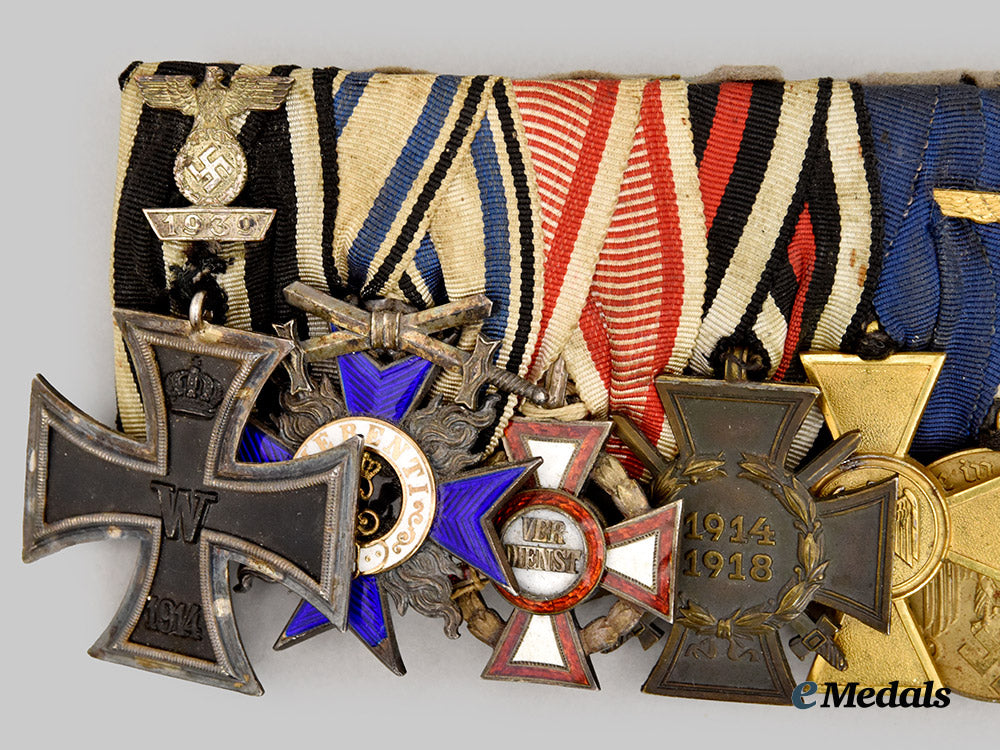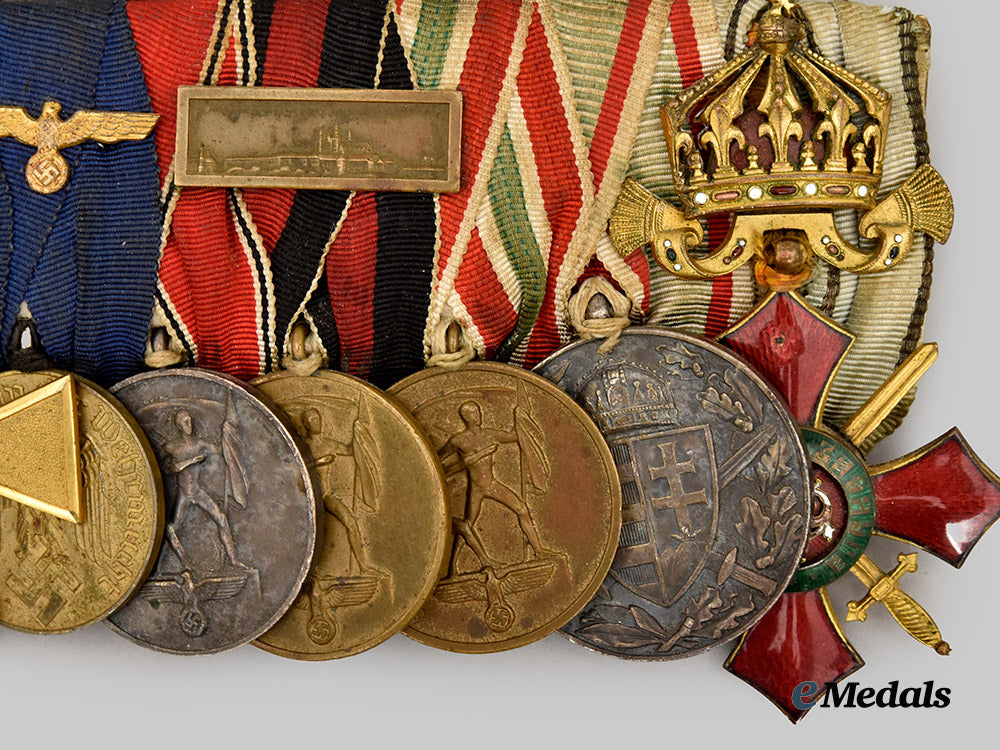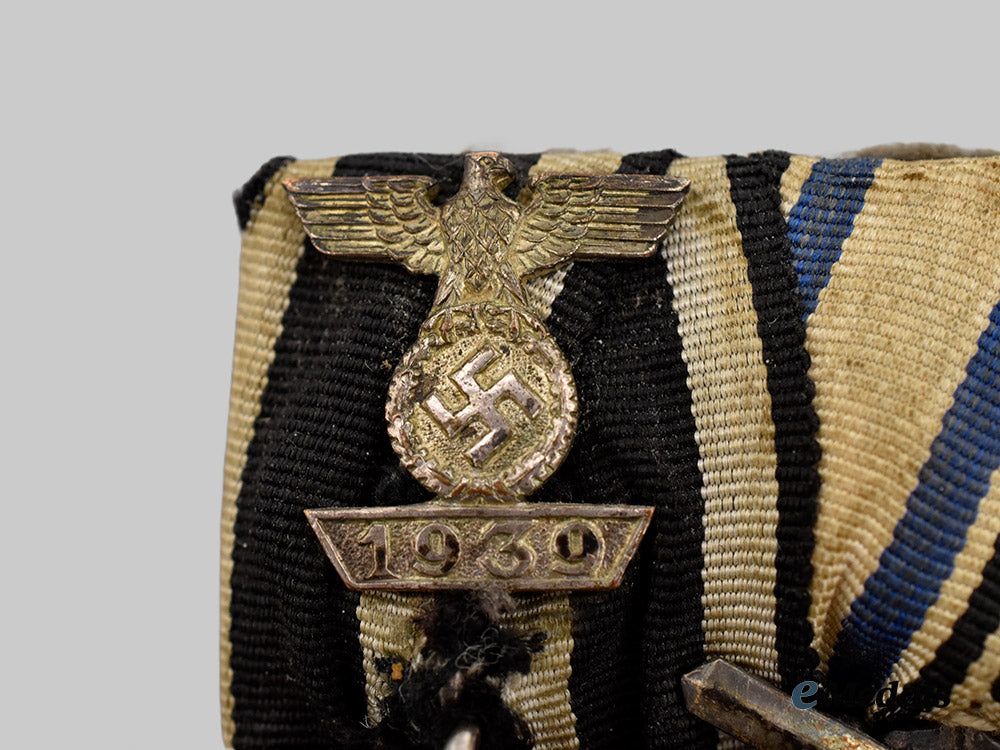
LOADING ...
In response to evolving domestic opinion, eMedals Inc has made the conscious decision to remove the presentation of German Third Reich historical artifacts from our online catalogue. For three decades, eMedals Inc has made an effort to preserve history in all its forms. As historians and researchers, we have managed sensitive articles and materials with the greatest of care and respect for their past and present social context. We acknowledge the growing sentiments put forth by the Canadian public and have taken proactive actions to address this opinion.





Germany, Wehrmacht. The Historically Significant Medal Bar of General Erich Fellgiebel, 20th July Plotter
Germany, Wehrmacht. The Historically Significant Medal Bar of General Erich Fellgiebel, 20th July Plotter
SKU: ITEM: G56724
0% Buyer's Premium
Current Bid:
Your Max Bid:
Bid History:
Time Remaining:
Couldn't load pickup availability
Shipping Details
Shipping Details
eMedals offers rapid domestic and international shipping. Orders received prior to 12:00pm (EST) will be shipped on the same business day.* Orders placed on Canadian Federal holidays will be dispatched the subsequent business day. Courier tracking numbers are provided for all shipments. All items purchased from eMedals can be returned for a full monetary refund or merchandise credit, providing the criteria presented in our Terms & Conditions are met. *Please note that the addition of a COA may impact dispatch time.
Shipping Details
eMedals offers rapid domestic and international shipping. Orders received prior to 12:00pm (EST) will be shipped on the same business day.* Orders placed on Canadian Federal holidays will be dispatched the subsequent business day. Courier tracking numbers are provided for all shipments. All items purchased from eMedals can be returned for a full monetary refund or merchandise credit, providing the criteria presented in our Terms & Conditions are met. *Please note that the addition of a COA may impact dispatch time.
Description
Description
(Ordensschnalle für Widerstandskämpfer des 20. Juli 1944). An exceptional and historically significant medal bar from the estate of General Erich Fellgiebel, a career Heer (Army) Officer who became head of the Cipher Bureau of the Reichswehr and Wehrmacht following First World War service, and who later became a key conspirator of the 20th July 1944 plot to assassinate AH, for which he was tortured and executed. This superb bar features twelve decorations, including:
1. A 1914 Iron Cross II Class, constructed of iron and silver, on loop for suspension with its period original ribbon, consisting of a Cross Pattée with a blackened magnetic iron core within a ribbed silver frame, the obverse with a central initial “W”, the six o’clock arm with a reinstitution date of “1914”, the twelve o’clock arm with a royal crown, the reverse with three central oak leaves, the six o’clock arm with an initial institution date of “1813”, the twelve o’clock arm with initials “FW” topped by a royal crown, without visible marks, measuring 42.12 mm (w) x 46.41 mm (h), demonstrating a consistent patina throughout the frame, in extremely fine condition.
2. A 1939 Clasp to the Iron Cross II Class, constructed of silvered tombak, the obverse consisting of a Wehrmacht eagle perched on top of a wreathed mobile swastika, situated above a trapezoidal plaque bearing a raised date of “1939”, affixed with fully-intact reverse attachment prongs to the ribbon of the 1914 Iron Cross II Class, without visible marks, measuring 18.70 mm (w) x 20.14 mm (h), a fine-quality Prinzengröße example in near extremely fine condition.
3. A Bavarian Order of Military Merit, IV Class Cross with Swords, constructed of silvered with multi-coloured enamels, on loop for suspension with its period original ribbon, consisting of a Maltese Cross with blue enameled arms joined through the quadrants by stylized flames, the obverse bearing a central black enameled disc overlaid by a gilt monogram of King Ludwig II, situated within a stylized white enameled belt and buckle, bearing a gilt inscription of “MERENTI” (“MERIT”) with arabesques, the twelve o’clock arm riveted with a crossed sword clasp, the reverse bearing a central black enameled disc overlaid by a gilt Bavarian lion rampant, situated within a stylized white enameled belt and buckle, bearing a gilt institution date of “1866”, with arabesques, the twelve o’clock arm riveted with an arabesque suspension connecting to a loop hidden within the structure of the ribbon, the reverse of the suspension bearing a silver content number of “950” and a maker’s mark of “J.L.” indicating manufacture by Jacob Leser, Straubing, measuring 40.42 mm (w) x 42.98 mm (h) (exclusive of components hidden within the ribbon), chips are visible to the enamels of both the obverse and reverse of the six o’clock arm, in addition to minor cracking and flecking to the other arms, with a consistent patina visible throughout the base silver, in very fine condition.
4. An Austrian Military Merit Cross, III Class, constructed of silver with multi-coloured enamels, on loop for suspension with its period original ribbon, consisting of a Cross Pattée with its arms joined through the quadrants by a circular laurel leaf wreath, the obverse with white enameled arms trimmed with red enameled borders, bearing a central white enameled medallion overlaid by a raised silver inscription of “VERDIENST” (“MERIT”), situated within a red enameled ring, the reverse with arms and centrepiece executed in white enamels, without visible marks, measuring 30.87 mm (w) x 33.51 mm (h), demonstrating minor flecking and scratching throughout the enamels, in near extremely fine condition.
5. An Honour Cross of the World War 1914/1918 for Combatants, constructed of bronzed magnetic metal, on loop for suspension with its period original ribbon, consisting of a Cross Pattée with crossed swords piercing the centrepiece, the obverse bearing central wreathed dates “1914-1918”, the reverse maker marked with the logo of Glaser & Söhne, Dresden, measuring 37.59 mm (w) x 42.34 mm (h), in extremely fine condition.
6. A Wehrmacht 25-Year Long Service Award, constructed of gilded magnetic metal, on loop for suspension with its period original ribbon, consisting of a Cross Pattée with pebbled arms, the obverse bearing a central raised Heer-style German national eagle clutching a mobile swastika, the reverse bearing a central raised number “25”, unmarked, measuring 40.50 mm (w) x 45.10 mm (h), in extremely fine condition.
7. A Wehrmacht 12-Year Long Service Medal, constructed of gilded magnetic metal, on loop for suspension with its period original ribbon pinned with Heer device, the obverse bearing a central raise German national eagle clutching a mobile swastika, circumscribed by an inscription of “TREUE DIENSTE IN DER WEHRMACHT” (“FAITHFUL SERVICE IN THE WEHRMACHT”), the reverse bearing a wreathed number “12”, unmarked, measuring 29.86 mm in diameter, demonstrating minor loss of finish, in near extremely fine condition.
8. An Anschluss Medal, constructed of silvered bronze, on loop for suspension with its period original ribbon, the obverse bearing two raised figures, one of which is clutching a flag and the other a length of broke chain, above a German national eagle clutching a wreathed mobile swastika, the reverse bearing a central raised date of “13. MÄRZ 1938”, circumscribed by an inscription of “EIN VOLK, EIN REICH, EIN FÜHRER” (“ONE PEOPLE, ONE NATION, ONE LEADER”), unmarked, measuring 31.97 mm in diameter, demonstrating near-total loss of silver finish to the base metal, in very fine condition.
9. A Sudetenland Medal, constructed of bronze, on loop for suspension with its period original ribbon pinned with Prague Castle Bar, the obverse bearing two raised figures, one of which is clutching a flag and the other a length of broke chain, above a German national eagle clutching a wreathed mobile swastika, the reverse bearing a central raised date of “13. MÄRZ 1938”, circumscribed by an inscription of “EIN VOLK, EIN REICH, EIN FÜHRER” (“ONE PEOPLE, ONE NATION, ONE LEADER”), unmarked, measuring 32.19 mm in diameter, in extremely fine condition.
10. A Memel Medal, constructed of bronze, on loop for suspension with its period original ribbon, the obverse bearing two raised figures, one of which is clutching a flag and the other a length of broke chain, above a German national eagle clutching a wreathed mobile swastika, the reverse bearing an inscription of “ZUR ERINNERUNG AN DIE HEIMKEHR DES MEMELLANDES 22. MÄRZ 1939” (“IN MEMORY OF THE HOMECOMING OF MEMELLAND 22 MARCH 1939”) situated within a circular oak leaf wreath joined together at the bottom by ribbon, with etched initials “H.C.” visible just beneath the ribbon for engraver Eduard Hanish-Concée, other unmarked but demonstrating the characteristics of manufacture by the Berlin Mint, measuring 32.22 mm in diameter, in extremely fine condition.
11. A Hungarian War Commemorative Medal, constructed of silvered bronze, on loop for suspension with its period original ribbon, unmarked, measuring 37.08 mm in diameter, demonstrating moderate loss of silver finish throughout, in near extremely fine condition.
12. A Bulgarian Order of Military Merit, IV Class Cross, constructed of gilded bronze with multi-coloured enamels, consisting of a Pisan Cross with red enameled arms and crossed swords piercing the centrepiece, the obverse bearing a central red enameled disc, overlaid by a raised and white enameled monogram of Ferdinand I, situated within a green enameled ring bearing a gilt Cyrillic inscription of “ЗА ВОЕННА ЗАСЛУГА” (“FOR MILITARY MERIT”), the reverse bearing a central red enameled medallion overlaid by a raised and gilded Bulgarian lion rampant, situated within a green enameled ring bearing a gilt institution date of “2 АВГУСТЪ 1891” (“2 AUGUST 1891”), the twelve o’clock arm topped by an elaborate gilt crown suspension, unmarked, the cross measuring 50.66 mm (w) x 54.94 mm (h), chipping is visible to the enamels of both the obverse and reverse of the twelve o’clock arm, in addition to the obverse monogram, in very fine condition.
All suspended from a 20 cm-long bronze bar with a horizontal pinback and partially-intact grey wool liner, stitched with a maker’s label reading “GEBR. GODET & CO., ORDENSJUWELIERE, BERLIN, CHARLOTTENSTR. 55”, demonstrating some displacement and mothing to the reverse liner with age-appropriate soiling visible throughout the award ribbons, an exceptional bar to a noted figure of both the Wehrmacht and German Resistance in very fine condition.
Footnote: Exhaustive research by Daniel Krause, a noted researcher of medals and orders, positively identified this bar, with its combination of awards and quality of construction, as undoubtedly attributable to Erich Fellgiebel.
Footnote: Erich Fellgiebel was born on 4 October 1886 in Pöpelwitz, Germany (now Popolwice, Poland). He enlisted in the Prussian Army in September 1905, serving with Telegraphen-Bataillon Nr. 2 as a flag cadet. Demonstrating exemplary conduct, Fellgiebel was rapidly promoted to Officer and served with distinction throughout the First World War, where he was assigned to the General Staff. He remained in Reichswehr service following the cessation of hostilities, and was promoted to Major in 1928, Oberstleutnant in 1933, and Oberst in 1934. The same year, Fellgiebel was appointed to the Heer Signals Establishment, and in this capacity was key to the development of the infamous Enigma machine. Ironically, and fortuitously, Fellgiebel was distrusted by the Führer, but his expertise in pioneering coded communications in the Wehrmacht proved essential to the war effort. After becoming acquainted with General Ludwig Beck, a former Chief of the General Staff who had become a driving force in the clandestine German Resistance, Fellgiebel quickly became enmeshed in anti-party activity, and fed information to the Soviet spy ring “Red Orchestra”, supplying information that, among other initiatives, gave the Red Army critical warnings ahead of the pivotal 1943 Battle of Kursk. Part of the inner circle of conspirators involved in Operation Valkyrie and the 20th of July Plot, he was tasked with disrupting communications from the Wolf’s Lair in East Prussia, but was foiled when separate SS channels were able to inform Reichsminister Joseph Goebbels that AH had survived the bombing. Notably, it was Fellgiebel who, via telephone call, informed his co-conspirators at the Bendlerblock that the Führer was alive and re-establishing control of the Reich. He was immediately arrested and tortured for information on the conspiracy, but notably did not reveal any names. Condemned by the Volksgerichtshof, he was executed on 4 September 1944 at Plötzensee Prison in Berlin.
Description
(Ordensschnalle für Widerstandskämpfer des 20. Juli 1944). An exceptional and historically significant medal bar from the estate of General Erich Fellgiebel, a career Heer (Army) Officer who became head of the Cipher Bureau of the Reichswehr and Wehrmacht following First World War service, and who later became a key conspirator of the 20th July 1944 plot to assassinate AH, for which he was tortured and executed. This superb bar features twelve decorations, including:
1. A 1914 Iron Cross II Class, constructed of iron and silver, on loop for suspension with its period original ribbon, consisting of a Cross Pattée with a blackened magnetic iron core within a ribbed silver frame, the obverse with a central initial “W”, the six o’clock arm with a reinstitution date of “1914”, the twelve o’clock arm with a royal crown, the reverse with three central oak leaves, the six o’clock arm with an initial institution date of “1813”, the twelve o’clock arm with initials “FW” topped by a royal crown, without visible marks, measuring 42.12 mm (w) x 46.41 mm (h), demonstrating a consistent patina throughout the frame, in extremely fine condition.
2. A 1939 Clasp to the Iron Cross II Class, constructed of silvered tombak, the obverse consisting of a Wehrmacht eagle perched on top of a wreathed mobile swastika, situated above a trapezoidal plaque bearing a raised date of “1939”, affixed with fully-intact reverse attachment prongs to the ribbon of the 1914 Iron Cross II Class, without visible marks, measuring 18.70 mm (w) x 20.14 mm (h), a fine-quality Prinzengröße example in near extremely fine condition.
3. A Bavarian Order of Military Merit, IV Class Cross with Swords, constructed of silvered with multi-coloured enamels, on loop for suspension with its period original ribbon, consisting of a Maltese Cross with blue enameled arms joined through the quadrants by stylized flames, the obverse bearing a central black enameled disc overlaid by a gilt monogram of King Ludwig II, situated within a stylized white enameled belt and buckle, bearing a gilt inscription of “MERENTI” (“MERIT”) with arabesques, the twelve o’clock arm riveted with a crossed sword clasp, the reverse bearing a central black enameled disc overlaid by a gilt Bavarian lion rampant, situated within a stylized white enameled belt and buckle, bearing a gilt institution date of “1866”, with arabesques, the twelve o’clock arm riveted with an arabesque suspension connecting to a loop hidden within the structure of the ribbon, the reverse of the suspension bearing a silver content number of “950” and a maker’s mark of “J.L.” indicating manufacture by Jacob Leser, Straubing, measuring 40.42 mm (w) x 42.98 mm (h) (exclusive of components hidden within the ribbon), chips are visible to the enamels of both the obverse and reverse of the six o’clock arm, in addition to minor cracking and flecking to the other arms, with a consistent patina visible throughout the base silver, in very fine condition.
4. An Austrian Military Merit Cross, III Class, constructed of silver with multi-coloured enamels, on loop for suspension with its period original ribbon, consisting of a Cross Pattée with its arms joined through the quadrants by a circular laurel leaf wreath, the obverse with white enameled arms trimmed with red enameled borders, bearing a central white enameled medallion overlaid by a raised silver inscription of “VERDIENST” (“MERIT”), situated within a red enameled ring, the reverse with arms and centrepiece executed in white enamels, without visible marks, measuring 30.87 mm (w) x 33.51 mm (h), demonstrating minor flecking and scratching throughout the enamels, in near extremely fine condition.
5. An Honour Cross of the World War 1914/1918 for Combatants, constructed of bronzed magnetic metal, on loop for suspension with its period original ribbon, consisting of a Cross Pattée with crossed swords piercing the centrepiece, the obverse bearing central wreathed dates “1914-1918”, the reverse maker marked with the logo of Glaser & Söhne, Dresden, measuring 37.59 mm (w) x 42.34 mm (h), in extremely fine condition.
6. A Wehrmacht 25-Year Long Service Award, constructed of gilded magnetic metal, on loop for suspension with its period original ribbon, consisting of a Cross Pattée with pebbled arms, the obverse bearing a central raised Heer-style German national eagle clutching a mobile swastika, the reverse bearing a central raised number “25”, unmarked, measuring 40.50 mm (w) x 45.10 mm (h), in extremely fine condition.
7. A Wehrmacht 12-Year Long Service Medal, constructed of gilded magnetic metal, on loop for suspension with its period original ribbon pinned with Heer device, the obverse bearing a central raise German national eagle clutching a mobile swastika, circumscribed by an inscription of “TREUE DIENSTE IN DER WEHRMACHT” (“FAITHFUL SERVICE IN THE WEHRMACHT”), the reverse bearing a wreathed number “12”, unmarked, measuring 29.86 mm in diameter, demonstrating minor loss of finish, in near extremely fine condition.
8. An Anschluss Medal, constructed of silvered bronze, on loop for suspension with its period original ribbon, the obverse bearing two raised figures, one of which is clutching a flag and the other a length of broke chain, above a German national eagle clutching a wreathed mobile swastika, the reverse bearing a central raised date of “13. MÄRZ 1938”, circumscribed by an inscription of “EIN VOLK, EIN REICH, EIN FÜHRER” (“ONE PEOPLE, ONE NATION, ONE LEADER”), unmarked, measuring 31.97 mm in diameter, demonstrating near-total loss of silver finish to the base metal, in very fine condition.
9. A Sudetenland Medal, constructed of bronze, on loop for suspension with its period original ribbon pinned with Prague Castle Bar, the obverse bearing two raised figures, one of which is clutching a flag and the other a length of broke chain, above a German national eagle clutching a wreathed mobile swastika, the reverse bearing a central raised date of “13. MÄRZ 1938”, circumscribed by an inscription of “EIN VOLK, EIN REICH, EIN FÜHRER” (“ONE PEOPLE, ONE NATION, ONE LEADER”), unmarked, measuring 32.19 mm in diameter, in extremely fine condition.
10. A Memel Medal, constructed of bronze, on loop for suspension with its period original ribbon, the obverse bearing two raised figures, one of which is clutching a flag and the other a length of broke chain, above a German national eagle clutching a wreathed mobile swastika, the reverse bearing an inscription of “ZUR ERINNERUNG AN DIE HEIMKEHR DES MEMELLANDES 22. MÄRZ 1939” (“IN MEMORY OF THE HOMECOMING OF MEMELLAND 22 MARCH 1939”) situated within a circular oak leaf wreath joined together at the bottom by ribbon, with etched initials “H.C.” visible just beneath the ribbon for engraver Eduard Hanish-Concée, other unmarked but demonstrating the characteristics of manufacture by the Berlin Mint, measuring 32.22 mm in diameter, in extremely fine condition.
11. A Hungarian War Commemorative Medal, constructed of silvered bronze, on loop for suspension with its period original ribbon, unmarked, measuring 37.08 mm in diameter, demonstrating moderate loss of silver finish throughout, in near extremely fine condition.
12. A Bulgarian Order of Military Merit, IV Class Cross, constructed of gilded bronze with multi-coloured enamels, consisting of a Pisan Cross with red enameled arms and crossed swords piercing the centrepiece, the obverse bearing a central red enameled disc, overlaid by a raised and white enameled monogram of Ferdinand I, situated within a green enameled ring bearing a gilt Cyrillic inscription of “ЗА ВОЕННА ЗАСЛУГА” (“FOR MILITARY MERIT”), the reverse bearing a central red enameled medallion overlaid by a raised and gilded Bulgarian lion rampant, situated within a green enameled ring bearing a gilt institution date of “2 АВГУСТЪ 1891” (“2 AUGUST 1891”), the twelve o’clock arm topped by an elaborate gilt crown suspension, unmarked, the cross measuring 50.66 mm (w) x 54.94 mm (h), chipping is visible to the enamels of both the obverse and reverse of the twelve o’clock arm, in addition to the obverse monogram, in very fine condition.
All suspended from a 20 cm-long bronze bar with a horizontal pinback and partially-intact grey wool liner, stitched with a maker’s label reading “GEBR. GODET & CO., ORDENSJUWELIERE, BERLIN, CHARLOTTENSTR. 55”, demonstrating some displacement and mothing to the reverse liner with age-appropriate soiling visible throughout the award ribbons, an exceptional bar to a noted figure of both the Wehrmacht and German Resistance in very fine condition.
Footnote: Exhaustive research by Daniel Krause, a noted researcher of medals and orders, positively identified this bar, with its combination of awards and quality of construction, as undoubtedly attributable to Erich Fellgiebel.
Footnote: Erich Fellgiebel was born on 4 October 1886 in Pöpelwitz, Germany (now Popolwice, Poland). He enlisted in the Prussian Army in September 1905, serving with Telegraphen-Bataillon Nr. 2 as a flag cadet. Demonstrating exemplary conduct, Fellgiebel was rapidly promoted to Officer and served with distinction throughout the First World War, where he was assigned to the General Staff. He remained in Reichswehr service following the cessation of hostilities, and was promoted to Major in 1928, Oberstleutnant in 1933, and Oberst in 1934. The same year, Fellgiebel was appointed to the Heer Signals Establishment, and in this capacity was key to the development of the infamous Enigma machine. Ironically, and fortuitously, Fellgiebel was distrusted by the Führer, but his expertise in pioneering coded communications in the Wehrmacht proved essential to the war effort. After becoming acquainted with General Ludwig Beck, a former Chief of the General Staff who had become a driving force in the clandestine German Resistance, Fellgiebel quickly became enmeshed in anti-party activity, and fed information to the Soviet spy ring “Red Orchestra”, supplying information that, among other initiatives, gave the Red Army critical warnings ahead of the pivotal 1943 Battle of Kursk. Part of the inner circle of conspirators involved in Operation Valkyrie and the 20th of July Plot, he was tasked with disrupting communications from the Wolf’s Lair in East Prussia, but was foiled when separate SS channels were able to inform Reichsminister Joseph Goebbels that AH had survived the bombing. Notably, it was Fellgiebel who, via telephone call, informed his co-conspirators at the Bendlerblock that the Führer was alive and re-establishing control of the Reich. He was immediately arrested and tortured for information on the conspiracy, but notably did not reveal any names. Condemned by the Volksgerichtshof, he was executed on 4 September 1944 at Plötzensee Prison in Berlin.





You May Also Like
Germany, SA. A Model 1933 Service Dagger, SA-Gruppe Nordsee, by Friedrich von der Kohlen
G59818
Germany, SA. A Model 1933 Service Dagger, SA-Gruppe Pommern, by Gustav Wirth
G59816
Germany, Third Reich. A Mixed Lot of Tyrolean Marksmanship Badges
G52930
Germany, SS. An Estonian Waffen-SS Volunteer’s Sleeve Shield
G50381
Germany, SS. A Waffen-SS Sturmmann Sleeve Insignia
G52846
-
Germany, SA. A Model 1933 Service Dagger, SA-Gruppe Nordsee, by Friedrich von der Kohlen
G59818
Add to CartRegular price $980 USDRegular price $0 USD Sale price $980 USDUnit price / per -
Germany, SA. A Model 1933 Service Dagger, SA-Gruppe Pommern, by Gustav Wirth
G59816
Add to CartRegular price $980 USDRegular price $0 USD Sale price $980 USDUnit price / per -
Germany, Third Reich. A Mixed Lot of Tyrolean Marksmanship Badges
G52930
Add to CartRegular price $135 USDRegular price $0 USD Sale price $135 USDUnit price / per -
Germany, SS. An Estonian Waffen-SS Volunteer’s Sleeve Shield
G50381
Add to CartRegular price $150 USDRegular price $0 USD Sale price $150 USDUnit price / per -
Germany, SS. A Waffen-SS Sturmmann Sleeve Insignia
G52846
Add to CartRegular price $135 USDRegular price $0 USD Sale price $135 USDUnit price / per
Do you have a similar item you are interested in selling?
Please complete the form and our client care representatives will contact you.
Sell Item














